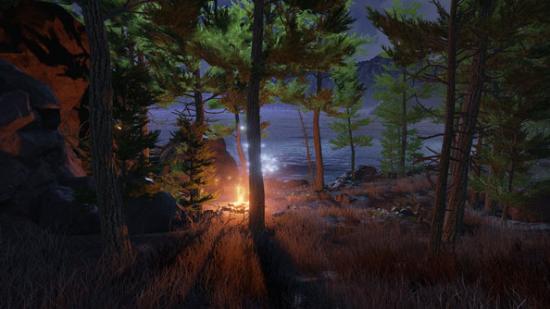Myst was perhaps the first PC game to truly crossover to the study shelves of the mainstream – and though some of its strengths have aged monstrously, others are eternal. In Cyan World’s upcoming Obduction – Kickstarted to the tune of $1,321,306 – players don’t take on a role. They play themselves, whisked away to an impossible world.
“I think there’s some real power in that,” muses ‘90s gaming figurehead Rand Miller. “If what we’re trying to do is help a player suspend their disbelief, then one of the first steps that can help that is not to try and convince you that you’re somebody else.”
It’s the escapist fantasy of falling out of the everyday – common in Narnia and Spirited Away, Star Wars and Lord of the Rings.
“What would you do if this happened to you?,” asks Miller. “It’s worked for us in the past, and we’d kind of like to embrace that.”
There’s more of Myst and its sequel, Riven, that still works than you’d probably imagine. While Cyan games once stood alone in their lonely environments and pedestrian pacing, a whole genre has grown up around them: walking simulators – a derogatory term reclaimed by the developers of some unusually creative contemporary games.
For Obduction, Cyan have pulled from the design of Gone Home, the beauty of Dear Esther, and the tactile manipulation of The Room. Art director Eric Anderson’s last project was The Witness – whose Jonathan Blow often cites Myst as an influence – and the tools he used there have inspired those he’s built at Cyan.
“We wear the walking simulator badge proudly,” says Miller. “We pick little seeds from things that really motivate us.”
While the Spokane studio have worked with Unity and proprietary engines in the past, they’ve picked Unreal Engine 4 for Obduction. There’s a sense that Cyan, who once proved the untested CD-ROM, like to pick apart new tech.
“It’s this odd balance where if you get too far ahead of the curve, it gets difficult to actually ship the product,” explains Miller. “You’ve got to try and hit it just at the right time.
“I think we all felt that UE4 was good timing for us. It was out ahead enough, but not too much that we couldn’t ship or have bugs that were unresolved.”
Cyan were particularly keen on being able to dig into the engine’s source code – not least because their needs are somewhat different to those of the games Unreal traditionally propped up.
“We’re using an engine that was primarily used for first-person shooters,” points out programmer Jason Calvert. “Our user interaction is quite a bit different.”
Obduction needed a cursor, for starters – and the ability not only to click and release, but also to drag objects. Cyan have put a lot of work, too, into collisions clean enough to support plenty of player meandering. But there’s still some way to go. Stand in the sunlight in their prototype build, and you’ll see the shadow of a holstered mercenary.
“He looks really buff,” laughs Miller. “Like he always want to carry a gun and beat the crap out of people”.
As in Myst and Riven, environments run the gamut from the familiar to the alien. Cyan reckon Obduction’s palette is a little brighter and more saturated than that of its relations – since they can do more in the way of illumination and luminosity. But at least one element will grant Obduction a “reach-back feel” – its FMV personalities.
“There’s definitely been a trend away from putting live action characters in a game – it’s mostly CG,” says Miller. “But we felt because we had a legacy of live action we could, if we felt it was best, reach back to that. And after much gnashing of teeth and examining all the options, we decided that was the best way to do it.”
The technical challenge has lay in slotting 2D images into a fully-explorable 3D world. Cyan have embedded their FMV in sci-fi ‘imagers’, and picked other “controlled circumstances” for conversation – think BioShock’s tendency to stick plot-critical characters behind glass.
These are hardly flat images, though – Cyan have filmed their actors in stereo, so if you’re playing in VR it “looks pretty convincing”. A meeting of classic and contemporary PC gaming.
“I think a lot of the design process is based on what we’ve done in the past, either consciously or subconsciously.” admits Miller. “It’s interesting to see those parallels and how they sneak in and surprise us on occasion. In Myst it was a linking book, but really it’s just a portal – a portal that takes you to another place.”
Obduction is expected on PC later this year. Unreal Engine 4 development is now free.
In this sponsored series, we’re looking at how game developers are taking advantage of Unreal Engine 4 to create a new generation of PC games. With thanks to Epic Games and Cyan Worlds.
